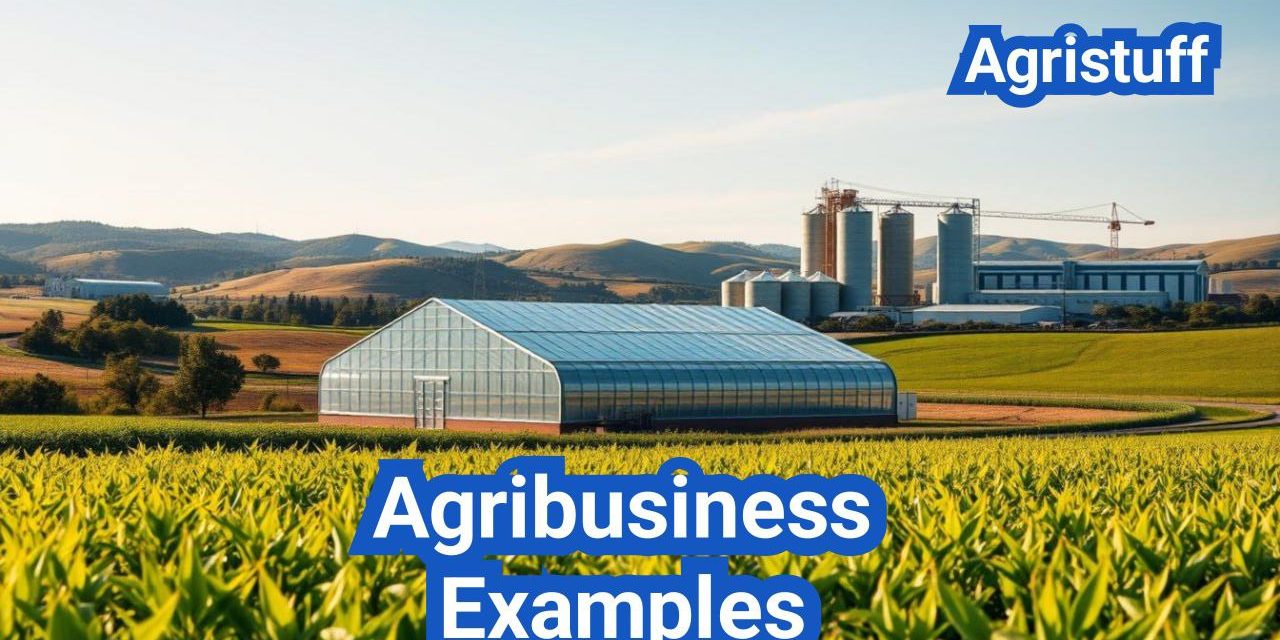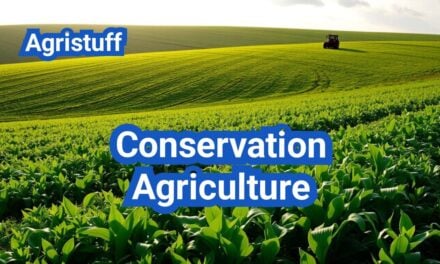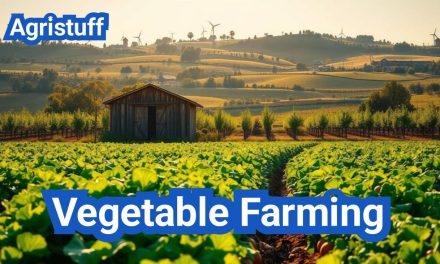The agricultural sector is a complex and multifaceted industry that encompasses the entire value chain, from raw materials to end consumers. Agribusiness plays a vital role in this sector, involving farming, processing, and distribution of agricultural products.
Understanding the various agribusiness examples is crucial for entrepreneurs, farmers, and stakeholders looking to navigate this complex landscape. This comprehensive guide will explore the different aspects of the agricultural business sector, providing valuable insights and information.
Key Takeaways
- Agribusiness encompasses the entire agricultural value chain.
- Understanding agribusiness examples is crucial for industry stakeholders.
- The agricultural business sector is complex and multifaceted.
- Agribusiness involves farming, processing, and distribution.
- Navigating the agricultural landscape requires comprehensive knowledge.
The Fundamentals of Agribusiness
At its core, agribusiness involves a multifaceted approach to agricultural production, processing, and distribution. The agribusiness sector is not limited to farming alone; it encompasses a broad range of activities, including input provision, production, processing, and service provision.
The agribusiness sector is a complex network of enterprises that work together to bring food and other agricultural products to consumers. This includes four main links: input providers who supply seeds, fertilizers, and equipment; producers who grow and raise crops and livestock; processors who transform raw products into consumable goods; and other service providers who offer expertise in areas such as finance, logistics, and technology.
Defining the Agribusiness Sector
The agribusiness sector is defined by its integration of various agricultural activities into a cohesive system. This integration enables the efficient production, processing, and distribution of agricultural products. The sector is characterized by its use of technology, innovative practices, and commitment to sustainability.
Agribusiness enterprises range from small, family-owned operations to large, multinational corporations. Regardless of size, these enterprises are connected through their focus on agricultural production and their contribution to the global food system.
Economic Impact of Agricultural Enterprises
The economic impact of agricultural enterprises is significant, contributing substantially to the global GDP and employing a substantial workforce. Agribusinesses create jobs not only in farming but also in related industries such as manufacturing, transportation, and retail.
Agricultural enterprises also play a crucial role in ensuring food security, both locally and globally. By adopting innovative practices and technologies, these enterprises can improve crop yields, reduce waste, and enhance the quality of their products.
| Economic Indicator | Contribution of Agribusiness |
|---|---|
| Global GDP | Significant contributor |
| Employment | Substantial workforce |
| Food Security | Critical role in ensuring global food security |
In conclusion, the fundamentals of agribusiness are rooted in its definition as a multifaceted sector that encompasses various agricultural activities. The economic impact of agricultural enterprises is profound, contributing to the global economy and ensuring food security worldwide.
Essential Components of Successful Agribusiness Models

The most effective agribusiness models incorporate a combination of strategic practices. These practices are crucial for navigating the complexities of the agricultural industry and achieving long-term success.
Integrated Supply Chain Management | Agribusiness Examples
Integrated supply chain management is a critical component of successful agribusiness models. It involves coordinating the flow of goods, services, and information from raw materials to end customers. Effective supply chain management enables agribusinesses to respond to changing market conditions, reduce costs, and improve customer satisfaction.
By leveraging technology and data analytics, agribusinesses can optimize their supply chains, predict demand, and manage inventory more efficiently. This can lead to improved profitability and competitiveness in the market.
Strategic Resource Allocation | Agribusiness Examples
Strategic resource allocation is another essential element of successful agribusiness models. It involves allocating resources such as land, labor, and capital in a way that maximizes returns and minimizes waste. Agribusinesses must carefully plan and manage their resources to ensure they are being used efficiently.
This can involve adopting new technologies, investing in employee training, and implementing sustainable practices. By allocating resources effectively, agribusinesses can improve productivity, reduce costs, and enhance their environmental sustainability.
Risk Management Practices | Agribusiness Examples
Risk management practices are vital for mitigating the various risks associated with agribusiness, such as weather events, market fluctuations, and regulatory changes. Effective risk management involves identifying potential risks, assessing their likelihood and impact, and implementing strategies to mitigate them.
Agribusinesses can use various tools and techniques to manage risk, including insurance products, hedging strategies, and diversification. By proactively managing risk, agribusinesses can reduce their exposure to potential losses and ensure long-term viability.
Prominent Agribusiness Examples Across Sectors
The agribusiness sector encompasses a wide range of activities, from primary production to value-added processing. This diversity is a key strength of the industry, allowing it to meet various consumer needs and adapt to changing market conditions.
Agribusiness examples can be seen in different sectors, each playing a crucial role in the overall agricultural value chain. These sectors include primary production enterprises, which form the foundation of the industry.
Primary Production Enterprises | Agribusiness Examples
Primary production enterprises are involved in the cultivation and harvesting of crops, as well as the raising of livestock. Examples include large-scale grain farms, dairy farms, and poultry production operations. These enterprises are essential for producing the raw materials that are used throughout the agricultural value chain.
Some notable examples of primary production enterprises include large commercial farms that specialize in crops such as corn and soybeans. These operations often employ advanced technology and farming practices to maximize yields and efficiency.
Value-Added Processing Operations | Agribusiness Examples
Value-added processing operations transform raw agricultural products into higher-value goods. This can include activities such as food processing, packaging, and manufacturing of agricultural products. By adding value to raw commodities, these operations help to increase the profitability and sustainability of agricultural enterprises.
Examples of value-added processing operations include companies that specialize in organic food processing, meatpacking, and dairy product manufacturing. These businesses play a critical role in creating products that are ready for consumption or further processing.
Agricultural Service Providers | Agribusiness Examples
Agricultural service providers offer a range of services that support the agricultural industry. These can include farm equipment suppliers, agricultural consultants, and companies that provide financial services to farmers. By providing essential support services, these businesses help to facilitate the smooth operation of agricultural enterprises.
Examples of agricultural service providers include companies that specialize in precision agriculture technology, agricultural insurance providers, and businesses that offer logistics and transportation services to the agricultural sector.
Crop Production Business Models

Diverse crop production business models are pivotal in meeting the global food demand, with operations varying from large-scale grain farming to niche specialty crops. These models are crucial in ensuring food security and catering to the evolving consumer preferences.
Commercial Grain Farming Operations | Agribusiness Examples
Commercial grain farming is a significant component of the crop production sector. It involves large-scale cultivation of grains such as corn, wheat, and soybeans. These operations are often characterized by high mechanization and the use of advanced agricultural technologies to maximize yield and efficiency.
Key characteristics of commercial grain farming include:
- Large-scale land holdings
- Advanced machinery and technology
- Focus on high-yielding crop varieties
- Efficient supply chain management
Specialty and High-Value Crop Enterprises | Agribusiness Examples
Specialty and high-value crops offer opportunities for diversification within the crop production sector. These crops, which include fruits, vegetables, and nuts, are often grown for specific markets and can command higher prices due to their quality and uniqueness.
The advantages of specialty crop enterprises include:
- Higher profit margins
- Diversification of agricultural operations
- Catering to niche markets
- Potential for value-added processing
Organic and Certified Production Systems | Agribusiness Examples
Organic and certified production systems are gaining prominence due to the increasing consumer demand for sustainable and eco-friendly products. These systems involve practices that avoid the use of synthetic fertilizers, pesticides, and genetically modified organisms (GMOs).
Benefits of organic and certified production include:
- Premium pricing for organic products
- Environmental sustainability
- Access to niche markets
- Enhanced brand reputation
Livestock and Animal Production Enterprises
Animal production is a diverse and dynamic sector within agribusiness, featuring a range of operations from cattle and poultry to aquaculture. This sector is crucial for meeting the global demand for protein and other animal products.
Beef and Dairy Cattle Operations | Agribusiness Examples
Beef and dairy cattle operations are significant components of the livestock production industry. These enterprises involve the breeding, raising, and management of cattle for meat and dairy products. Modern cattle operations often incorporate advanced technologies and management practices to improve efficiency and sustainability.
Key aspects of beef and dairy cattle operations include:
- Breeding programs to enhance productivity and disease resistance
- Nutritional management to optimize cattle health and productivity
- Manure management to reduce environmental impact
Poultry and Egg Production Businesses | Agribusiness Examples
Poultry and egg production are other vital segments of the livestock industry. These businesses focus on raising chickens and other poultry for meat and egg production. Efficient poultry operations require careful management of health, nutrition, and living conditions.
Some key considerations for poultry and egg production include:
- Disease prevention and health management
- Nutritional strategies to enhance growth and egg production
- Welfare considerations to ensure humane treatment of birds
Aquaculture and Fishery Ventures | Agribusiness Examples
Aquaculture and fishery ventures represent a growing segment of animal production, providing a source of fish and seafood for global markets. These operations involve the cultivation of aquatic organisms in controlled environments or the harvesting of wild fish and seafood.
Key trends in aquaculture include:
- Adoption of sustainable practices to minimize environmental impact
- Use of technology to improve water quality and fish health
- Diversification of species to meet market demands
| Type of Operation | Primary Products | Key Challenges |
|---|---|---|
| Beef Cattle | Beef | Disease management, feed costs |
| Dairy Cattle | Milk, dairy products | Milk pricing, manure management |
| Poultry | Chicken meat, eggs | Disease prevention, welfare concerns |
| Aquaculture | Fish, seafood | Water quality, disease management |
Food Processing and Manufacturing Businesses
Food processing and manufacturing are integral to the agribusiness value chain, involving the transformation of raw agricultural commodities into consumer goods. This sector is crucial for meeting the dietary needs of a growing global population.
Grain Milling and Processing Companies | Agribusiness Examples
Grain milling and processing companies play a vital role in producing flour, cereals, and other grain products. These businesses are essential for creating staple foods consumed worldwide.
The process involves several stages, including cleaning, grinding, and packaging. Advanced technologies are employed to ensure product quality and safety.
Key Activities in Grain Milling:
- Receiving and storing grains
- Cleaning and processing grains
- Grinding and milling
- Packaging and distribution
Meat and Dairy Product Manufacturing | Agribusiness Examples
Meat and dairy product manufacturing involves processing raw meat and dairy into consumable products. This includes a wide range of activities, from slaughtering and meatpacking to dairy processing.
| Product Category | Examples | Processing Techniques |
|---|---|---|
| Meat Products | Sausages, Bacon, Ham | Curing, Smoking, Packaging |
| Dairy Products | Cheese, Butter, Yogurt | Pasturization, Fermentation, Packaging |
Specialty Food Production Enterprises | Agribusiness Examples
Specialty food production enterprises create niche products, often with unique flavors or ingredients. These businesses cater to diverse consumer preferences and dietary requirements.
Examples include artisanal cheeses, craft beers, and gourmet chocolates. The production of these items often involves traditional methods combined with modern quality control measures.
The diversity in specialty foods allows for innovation and differentiation in a competitive market.
Agricultural Input Supply Businesses

From seeds to fertilizers, and farm equipment to technology, agricultural input supply businesses are crucial for the success of farming operations. These enterprises provide the essential goods and services that farmers need to produce crops and raise livestock efficiently.
Seed Development and Distribution Companies | Agribusiness Examples
Seed development and distribution companies play a vital role in agriculture by providing high-quality seeds that are resistant to diseases and pests, and tailored to specific growing conditions. These companies invest heavily in research and development to improve crop yields and meet the evolving needs of farmers.
Key activities of seed development companies include:
- Breeding new seed varieties with desirable traits
- Conducting rigorous testing to ensure seed quality
- Distributing seeds to farmers through various channels
Fertilizer and Crop Protection Manufacturers | Agribusiness Examples
Fertilizer and crop protection manufacturers supply the chemicals necessary for crop nutrition and pest control. These products are crucial for maintaining soil fertility and protecting crops from damage.
| Product Type | Description | Benefits |
|---|---|---|
| Fertilizers | Chemical or organic products that provide essential nutrients to crops | Improved crop yields, enhanced soil fertility |
| Crop Protection Chemicals | Herbicides, insecticides, and fungicides that protect crops from pests and diseases | Reduced crop loss, improved crop quality |
Farm Equipment and Technology Providers | Agribusiness Examples
Farm equipment and technology providers offer machinery and innovative solutions that improve farming efficiency and productivity. This includes tractors, harvesters, precision farming tools, and farm management software.
The adoption of precision agriculture technologies, for instance, has revolutionized farming by enabling farmers to make data-driven decisions, reduce waste, and optimize resource use.
Distribution and Marketing Channels

The success of agribusinesses depends significantly on their ability to distribute and market their products effectively. In today’s competitive agricultural landscape, having a robust distribution network and marketing strategy is crucial for reaching consumers and staying ahead of the competition.
Wholesale Agricultural Commodity Trading | Agribusiness Examples
Wholesale agricultural commodity trading involves the bulk sale of agricultural products such as grains, coffee, and cotton. This segment plays a critical role in connecting producers with processors and manufacturers. Effective wholesale trading requires a deep understanding of market trends, quality standards, and logistical considerations.
For instance, companies like Cargill and Archer Daniels Midland are prominent players in the global agricultural commodity trading market. They facilitate the flow of commodities across the globe, providing essential services to farmers, processors, and consumers alike.
| Commodity | Major Producers | Primary Markets |
|---|---|---|
| Corn | United States, China, Brazil | Feed industry, Ethanol production |
| Soybeans | United States, Brazil, Argentina | Animal feed, Food processing |
| Wheat | China, India, Russia | Bread production, Pasta manufacturing |
Food Distribution Networks and Logistics | Agribusiness Examples
Food distribution networks and logistics are vital for ensuring that perishable goods reach consumers in a timely manner. This involves managing the transportation, storage, and handling of products to maintain their quality and freshness. Efficient logistics can significantly reduce costs and improve customer satisfaction.
“The future of food distribution lies in creating resilient and flexible supply chains that can adapt to changing consumer demands and environmental challenges.”
Companies like Sysco and US Foods are leading examples of businesses that have optimized their distribution networks to serve a wide range of customers, from restaurants to retailers.
Direct-to-Consumer Marketing Strategies | Agribusiness Examples
Direct-to-consumer marketing strategies allow agribusinesses to connect directly with their customers, bypassing traditional intermediaries. This approach enables businesses to build brand loyalty, gather customer feedback, and increase profit margins. Digital marketing tools and social media platforms are key enablers of direct-to-consumer marketing.
For example, farmers’ markets and community-supported agriculture (CSA) programs are popular direct-to-consumer models that have gained traction in recent years. These initiatives not only provide fresh produce to consumers but also help farmers increase their revenue.
- Utilize social media to engage with customers
- Develop e-commerce platforms for direct sales
- Participate in local farmers’ markets and events
By adopting these strategies, agribusinesses can enhance their distribution and marketing capabilities, ultimately driving growth and profitability in a competitive market.
Vertical Integration Success Stories

Vertical integration has emerged as a key strategy for agribusinesses seeking to enhance profitability and control over their value chain. By controlling multiple stages of production and distribution, companies can reduce costs, improve efficiency, and increase their market share.
Producer-Owned Processing Facilities | Agribusiness Examples
One successful approach to vertical integration involves producer-owned processing facilities. By processing their own products, farmers can capture more value from their crops and livestock. For instance, dairy farmers who own a processing facility can produce and package their own milk, cheese, and other dairy products, thereby increasing their profit margins.
Benefits of Producer-Owned Processing Facilities:
- Increased profit margins through value-added products
- Better control over product quality and branding
- Improved market flexibility and responsiveness
Farm-to-Table Business Models | Agribusiness Examples
Farm-to-table business models represent another successful vertical integration strategy. These models involve direct sales from farmers to consumers, often through online platforms, farmers’ markets, or community-supported agriculture (CSA) programs. This approach not only enhances the freshness and quality of produce but also promotes transparency and sustainability.
Retailer-Controlled Supply Chains | Agribusiness Examples
Retailer-controlled supply chains are a form of vertical integration where retailers manage the entire supply chain, from production to distribution. This strategy allows retailers to ensure consistent quality, reduce costs, and respond quickly to changing consumer demands. Examples include large grocery chains that own or contract with farms to supply their stores.
| Vertical Integration Strategy | Key Benefits | Examples |
|---|---|---|
| Producer-Owned Processing Facilities | Increased profit margins, better quality control | Dairy farmers processing their own milk |
| Farm-to-Table Business Models | Enhanced product freshness, transparency | CSAs, farmers’ markets, online direct sales |
| Retailer-Controlled Supply Chains | Consistent quality, reduced costs, quick response to demand | Large grocery chains owning or contracting farms |
Technology-Driven Agribusiness Innovations

The agribusiness sector is on the cusp of a technological revolution, driven by innovations that promise to enhance efficiency and productivity. As the global population continues to grow, the demand for food production is increasing, making it essential for agribusinesses to adopt cutting-edge technologies to meet this demand sustainably.
Precision Agriculture Companies | Agribusiness Examples
Precision agriculture companies are at the forefront of this technological revolution, providing tools and services that enable farmers to optimize crop yields and reduce waste. These companies offer a range of solutions, including GPS-guided farming equipment, drones for crop monitoring, and advanced irrigation systems.
By leveraging these technologies, farmers can make data-driven decisions, improving the efficiency of their operations. For instance, precision agriculture allows for the targeted application of fertilizers and pesticides, reducing environmental impact while maintaining productivity.
Agricultural Data Analytics Platforms | Agribusiness Examples
Agricultural data analytics platforms are another crucial component of technology-driven agribusiness innovations. These platforms collect and analyze data from various sources, including weather stations, soil sensors, and satellite imagery, to provide farmers with actionable insights.
By analyzing this data, farmers can predict crop yields, identify potential issues before they become major problems, and optimize their farming practices. This data-driven approach enables farmers to make informed decisions, reducing the risks associated with farming and improving overall productivity.
Automation and Robotics in Farming | Agribusiness Examples
Automation and robotics are transforming farming practices, making them more efficient and less labor-intensive. From robotic milking systems to autonomous tractors, these technologies are revolutionizing the way farms operate.
Automation in farming not only reduces labor costs but also improves the accuracy and consistency of farming tasks. For example, robotic weeding and harvesting systems can perform tasks with precision, reducing crop loss and improving overall yield.
As technology continues to evolve, we can expect to see even more innovative solutions emerge in the agribusiness sector, further enhancing productivity and sustainability.
Sustainable and Regenerative Business Models

As the agribusiness sector continues to evolve, sustainable and regenerative business models are gaining significant attention. The growing awareness of environmental issues and the need for sustainable practices has led to the development of innovative business models that prioritize ecological stewardship.
The adoption of sustainable and regenerative practices in agribusiness not only contributes to environmental conservation but also enhances the long-term viability of agricultural enterprises. These models focus on improving soil health, biodiversity, and ecosystem services, ultimately leading to more resilient farming systems.
Carbon Sequestration and Credit Programs | Agribusiness Examples
Carbon sequestration and credit programs have emerged as a significant incentive for farmers to adopt environmentally friendly practices. These programs encourage the adoption of conservation agriculture, reforestation, and other practices that help sequester carbon dioxide from the atmosphere.
By participating in carbon credit programs, farmers can generate additional revenue streams while contributing to climate change mitigation. This approach not only benefits the environment but also provides economic benefits to agricultural producers.
Regenerative Agriculture Enterprises | Agribusiness Examples
Regenerative agriculture enterprises focus on improving soil health, biodiversity, and ecosystem services through the adoption of regenerative practices. These practices include no-till or reduced-till farming, cover cropping, and integrated livestock grazing.
Regenerative agriculture has been shown to improve soil carbon sequestration, reduce erosion, and enhance water retention. By adopting these practices, agricultural enterprises can improve their environmental sustainability while maintaining or improving productivity.
Circular Economy Applications in Agriculture | Agribusiness Examples
Circular economy applications in agriculture aim to reduce waste and promote resource efficiency. This approach involves the reuse and recycling of agricultural by-products, reducing the environmental impact of farming operations.
Examples of circular economy practices in agriculture include the use of organic waste as fertilizers, the recycling of water, and the utilization of crop residues as animal feed or bioenergy sources. By adopting circular economy principles, agricultural enterprises can reduce their environmental footprint while improving their economic viability.
International Agribusiness Examples

The international dimension of agribusiness is marked by complex global supply chains and diverse market players. This section explores various international agribusiness examples, highlighting the global nature of the industry.
Multinational Agricultural Corporations | Agribusiness Examples
Multinational corporations play a significant role in global agribusiness, operating across multiple countries and leveraging economies of scale. Companies like Cargill, Archer Daniels Midland (ADM), and Louis Dreyfus Company are prominent players in the global agricultural commodities market.
Emerging Market Success Stories | Agribusiness Examples
Emerging markets have become crucial for the growth of international agribusiness. Countries like Brazil, India, and China have seen significant developments in their agricultural sectors, driven by technological advancements and favorable policies. For instance, Brazil has become a major soybean exporter, while India has seen a rise in its agricultural exports due to government initiatives.
Cross-Border Agricultural Trade Enterprises | Agribusiness Examples
Cross-border trade is a vital component of international agribusiness, facilitating the exchange of agricultural products across countries. Enterprises involved in cross-border trade must navigate complex regulatory environments and logistical challenges.
| Aspect | Multinational Corporations | Emerging Markets | Cross-Border Trade |
|---|---|---|---|
| Scale of Operation | Global | Regional/National | International |
| Market Influence | High | Growing | Variable |
| Examples | Cargill, ADM | Brazil, India | Export-oriented companies |
The global agribusiness industry is characterized by its complexity and diversity, with international examples playing a crucial role in shaping the sector’s future. Understanding these examples is essential for businesses looking to navigate the global agricultural landscape.
Step-by-Step Guide to Starting an Agribusiness

Entrepreneurs looking to venture into agribusiness must navigate through several critical steps. Starting a successful agribusiness requires a comprehensive approach that includes understanding the market, developing a robust business plan, securing necessary financing, and ensuring regulatory compliance.
Market Research and Opportunity Identification | Agribusiness Examples
The first step in starting an agribusiness is conducting thorough market research to identify potential opportunities and challenges. This involves analyzing consumer demand, understanding market trends, and assessing the competitive landscape.
By gathering and analyzing data, entrepreneurs can make informed decisions about their business venture. Effective market research helps in identifying niche areas that are underserved or have potential for growth.
Business Plan Development | Agribusiness Examples
Developing a comprehensive business plan is crucial for the success of an agribusiness. The plan should outline the company’s mission, goals, production strategies, marketing approaches, and financial projections.
A well-crafted business plan serves as a roadmap for the business, helping entrepreneurs stay focused on their objectives and adapt to changing market conditions.
Securing Financing and Resources | Agribusiness Examples
Securing adequate financing is a critical step in launching and sustaining an agribusiness. Entrepreneurs can explore various funding options, including loans, grants, investors, and crowdfunding.
In addition to financial resources, agribusinesses need to secure other essential resources such as land, equipment, and skilled labor to ensure smooth operations.
Regulatory Compliance and Licensing | Agribusiness Examples
Ensuring regulatory compliance and obtaining necessary licenses is vital for the legitimacy and success of an agribusiness. This involves understanding and adhering to local, state, and federal regulations related to agricultural practices, environmental protection, and labor laws.
Compliance with regulatory requirements helps in avoiding legal issues and maintaining a positive reputation in the market.
Case Studies of Successful Agribusiness Ventures
Examining case studies of successful agribusiness ventures provides valuable insights into the factors that contribute to their success. These ventures demonstrate the potential for growth and innovation in the agricultural sector, showcasing a range of strategies that can be applied across different scales and types of operations.
Small-Scale Family Farm Transformations | Agribusiness Examples
Small-scale family farms are undergoing significant transformations by adopting modern technologies and innovative farming practices. For instance, the use of precision agriculture techniques has enabled these farms to increase efficiency and productivity. Precision farming involves the use of GPS-guided equipment, drones, and satellite imaging to optimize crop yields and reduce waste.
Another example is the diversification of farm products to include value-added goods, such as organic produce or specialty crops. This not only increases revenue but also helps in mitigating risks associated with crop failure or market fluctuations.
Mid-Size Agricultural Enterprise Growth Stories | Agribusiness Examples
Mid-size agricultural enterprises are achieving remarkable growth through strategic expansion and diversification. These businesses are leveraging economies of scale to improve their market position and competitiveness. Strategic partnerships and collaborations with other enterprises or research institutions are also playing a crucial role in their success.
For example, some mid-size enterprises are investing in advanced agricultural technologies, such as automated farming equipment and data analytics platforms, to enhance their operational efficiency and decision-making capabilities.
Corporate Agribusiness Innovations | Agribusiness Examples
Corporate agribusinesses are at the forefront of innovation in the agricultural sector, driving advancements in technology and business practices. Companies are developing and implementing cutting-edge solutions, such as vertical farming and biotechnology, to address global food security challenges.
These innovations are not only improving crop yields and disease resistance but also reducing the environmental impact of farming practices. Furthermore, corporate agribusinesses are exploring new markets and distribution channels, including direct-to-consumer sales models, to expand their reach and improve profitability.
Overcoming Challenges in Modern Agribusiness
The agribusiness sector is confronted with significant hurdles, including climate change, labor shortages, and supply chain disruptions. These challenges necessitate the adoption of innovative strategies to ensure the long-term sustainability of agricultural enterprises.
Climate Change Adaptation Strategies | Agribusiness Examples
Climate change poses a substantial threat to agribusiness, with rising temperatures and unpredictable weather patterns affecting crop yields and livestock productivity. To adapt to these changes, farmers and agricultural businesses are implementing various strategies.
- Precision agriculture techniques, such as drone technology and satellite imaging, help optimize resource use and reduce waste.
- Drought-resistant crop varieties and climate-resilient farming practices are being adopted to mitigate the impacts of climate change.
- Soil conservation methods, including no-till or reduced-till farming, improve soil health and increase its water-holding capacity.
These adaptation strategies not only help agribusinesses cope with climate change but also contribute to reducing their environmental footprint.
Labor and Workforce Solutions | Agribusiness Examples
The agribusiness sector faces significant labor challenges, including workforce shortages and the need for skilled labor. To address these issues, businesses are turning to innovative labor solutions.
| Labor Solution | Description | Benefits |
|---|---|---|
| Mechanization and Automation | Implementing machinery and automated systems to reduce manual labor. | Increased efficiency, reduced labor costs |
| Training and Development Programs | Providing workers with training to enhance their skills and productivity. | Improved workforce capability, increased job satisfaction |
| Immigration and Labor Policies | Advocating for policies that facilitate the legal employment of agricultural workers. | Stable workforce, compliance with regulations |
Supply Chain Resilience Building | Agribusiness Examples
Supply chain disruptions can have significant impacts on agribusinesses, from delays in input supplies to issues with product distribution. Building supply chain resilience is crucial for maintaining business continuity.
Strategies for enhancing supply chain resilience include:
- Diversifying suppliers to reduce dependence on single sources.
- Implementing robust logistics and inventory management systems.
- Developing contingency plans for potential disruptions.
By adopting these strategies, agribusinesses can better navigate the complexities of modern supply chains and ensure the timely delivery of products to markets.
Future Trends Shaping Agribusiness Opportunities
As we look to the future, agribusiness opportunities will be shaped by a combination of technological innovation, evolving consumer tastes, and regulatory changes. The agribusiness sector is poised for significant transformation, driven by these key factors.
Emerging Technologies and Digital Transformation | Agribusiness Examples
The integration of emerging technologies such as precision agriculture, artificial intelligence, and blockchain is revolutionizing the agribusiness landscape. Precision agriculture, for instance, enables farmers to optimize crop yields and reduce waste through data-driven decision-making. According to a report, “the global precision agriculture market is expected to grow from $7.1 billion in 2020 to $12.8 billion by 2025, at a Compound Annual Growth Rate (CAGR) of 12.7% during the forecast period.”
Digital transformation is also enhancing supply chain efficiency and transparency. Blockchain technology, for example, allows for secure and transparent tracking of produce from farm to table, building trust among consumers.
Changing Consumer Preferences and Market Demands | Agribusiness Examples
Consumer preferences are shifting towards sustainable and healthy food options, driving demand for organic and specialty products. Agribusinesses must adapt to these changing demands by diversifying their product offerings and adopting sustainable practices. As noted by a industry expert, “the organic food market is expected to continue its upward trend, with sales projected to reach $250 billion by 2025.”
- Increasing demand for organic and non-GMO products
- Growing interest in plant-based diets
- Rise of e-commerce platforms for food sales
Policy and Regulatory Evolution | Agribusiness Examples
Policy and regulatory changes will continue to shape the agribusiness landscape. Governments are implementing policies to promote sustainable agriculture, reduce carbon emissions, and ensure food safety. Agribusinesses must stay abreast of these changes to remain compliant and competitive. As stated in a recent policy brief, “regenerative agriculture practices are being incentivized through subsidies and tax breaks, encouraging farmers to adopt more sustainable methods.”
“The future of agriculture depends on our ability to innovate while preserving the planet for future generations.”
– Sonny Perdue, Former U.S. Secretary of Agriculture
In conclusion, the future of agribusiness will be characterized by technological innovation, evolving consumer preferences, and regulatory evolution. Businesses that adapt to these trends will be well-positioned for success in a rapidly changing agricultural landscape.
At The End of: Agribusiness Examples
The agribusiness sector is a multifaceted industry, influenced by various factors such as technological innovations, changing consumer preferences, and global market trends. As explored in this comprehensive guide, understanding the different components and examples of agribusiness is crucial for navigating this complex landscape.
In conclusion, the agribusiness industry is dynamic, with various stakeholders and components working together to meet the world’s growing food demands. As the industry continues to evolve, it is essential for stakeholders to stay informed about emerging trends and challenges, ultimately contributing to a more sustainable and efficient agribusiness conclusion.
An agricultural business summary highlights the importance of adapting to changing market conditions, leveraging technology, and promoting sustainable practices. By doing so, agribusinesses can capitalize on new opportunities and address the challenges facing the industry, ultimately shaping the future of agriculture.
FAQ
What is agribusiness, and what sectors does it encompass?
Agribusiness is a multifaceted industry that includes farming, processing, and distribution of agricultural products. It encompasses a broad range of activities, including input provision, production, processing, and service provision.
What are the essential components of successful agribusiness models?
Successful agribusiness models are built on integrated supply chain management, strategic resource allocation, and risk management practices.
What are some examples of agribusiness across different sectors?
Agribusiness examples include primary production enterprises, value-added processing operations, and agricultural service providers. Specific examples include commercial grain farming, specialty crop
How is technology driving innovation in agribusiness?
Technology is revolutionizing agribusiness through innovations like precision agriculture, data analytics, and automation. These advancements improve efficiency, productivity, and decision-making.
What are some sustainable and regenerative business models in agribusiness?
Sustainable and regenerative business models include carbon sequestration and credit programs, regenerative agriculture enterprises, and circular economy applications in agriculture.
What are the key steps to starting an agribusiness?
Starting an agribusiness involves market research and opportunity identification, business plan development, securing financing and resources, and regulatory compliance and licensing.
What are some challenges facing modern agribusiness, and how can they be overcome?
Modern agribusiness faces challenges like climate change, labor shortages, and supply chain disruptions. These challenges can be overcome through strategies like climate change adaptation, labor and workforce solutions, and supply chain resilience building.
What are the future trends shaping agribusiness opportunities?
Future trends shaping agribusiness include emerging technologies and digital transformation, changing consumer preferences and market demands, and policy and regulatory evolution.
What is the economic impact of agribusiness?
Agribusiness has a significant economic impact, contributing to the global GDP and employing a substantial workforce.
What are some examples of vertical integration in agribusiness?
Examples of vertical integration include producer-owned processing facilities, farm-to-table business models, and retailer-controlled supply chains.
How do agricultural input supply businesses support agricultural production?
Agricultural input supply businesses provide essential inputs like seeds, fertilizers, and equipment, supporting agricultural production and productivity.
What is the role of distribution and marketing channels in agribusiness?
Distribution and marketing channels play a crucial role in ensuring that agricultural products reach consumers efficiently, through channels like wholesale commodity trading, food distribution networks, and direct-to-consumer marketing.
Conclusion of: Agribusiness Examples
Agribusiness is the backbone of the global food supply chain, integrating agriculture with business principles to ensure efficiency, sustainability, and profitability. In this guide, we’ll explore agribusiness examples across various sectors, highlighting how different companies and operations contribute to feeding the world while driving economic growth. Whether you’re a farmer, investor, or simply curious about where your food comes from, understanding these agribusiness examples will give you insight into one of the most vital industries in the U.S. and beyond.
For more on the economic impact of agribusiness, check out this USDA report on agriculture contributions.
What Is Agribusiness?
Agribusiness encompasses all commercial activities related to farming, from production and processing to distribution and retail. Unlike traditional farming, which focuses solely on growing crops or raising livestock, agribusiness examples include seed manufacturers, food processors, agricultural tech firms, and even biofuel producers. This integrated approach ensures that food moves efficiently from farm to table while maximizing profitability and sustainability.
The U.S. agribusiness sector contributes over $1.5 trillion to the GDP, supporting millions of jobs 10. Companies like Cargill, ADM, and Tyson Foods dominate the industry, controlling large portions of grain, meat, and processed food markets 2.
To learn more about agribusiness definitions, visit Investopedia’s agribusiness breakdown.
Top Agribusiness Examples in the U.S.
The U.S. is home to some of the world’s largest and most innovative agribusiness companies. Below are key agribusiness examples shaping the industry:
- Cargill – A global leader in grain trading, meat processing, and food ingredients, generating $165 billion in revenue 2.
- Archer Daniels Midland (ADM) – Specializes in crop processing, turning corn into sweeteners, biofuels, and animal feed 26.
- Tyson Foods – The largest meat processor in the U.S., handling 20% of the nation’s chicken, beef, and pork 2.
- Bayer (Monsanto) – A major player in genetically modified seeds and crop protection chemicals 2.
- Land O’Lakes – A farmer-owned cooperative focusing on dairy products and agricultural technology 6.
For a deeper dive into top agribusiness firms, see Yahoo Finance’s ranking.
Agribusiness in Crop Production
Crop production is a fundamental agribusiness example, involving everything from seed development to large-scale farming. Companies like Corteva Agriscience focus on high-yield seeds, while others, such as AGCO Corp., manufacture advanced farming machinery like GPS-guided tractors 613.
The U.S. leads in corn, soybean, and wheat production, with innovations like precision agriculture boosting efficiency. For instance, automated systems can now optimize water and fertilizer use, saving farmers up to $400 per acre annually 6.
Explore more on crop production trends at Farm Progress.
Livestock and Meat Processing Agribusiness
Meat processing giants like Tyson Foods and Smithfield Foods dominate this sector, controlling much of America’s beef, pork, and poultry supply 2. These companies manage everything from animal feed to packaging, ensuring meat reaches supermarkets and restaurants efficiently.
Vertical integration is key—many agribusinesses own feedlots, slaughterhouses, and distribution networks, reducing costs and increasing control over quality. However, this concentration has raised concerns about market competition and animal welfare.
For insights into sustainable meat production, visit The Good Food Institute.
Agricultural Technology (AgTech) Innovations
Modern agribusiness examples increasingly rely on technology. Companies like Climate LLC (owned by Bayer) provide digital farming tools, while Pivot Bio develops microbial fertilizers to replace synthetic nitrogen 13. Other innovations include:
- Drones & Sensors – Monitor crop health and optimize irrigation.
- AI & Machine Learning – Predict yields and detect pests early.
- Blockchain – Enhances food traceability from farm to consumer.
These advancements help farmers reduce waste, cut costs, and meet sustainability goals.
Learn more about AgTech at AgFunder News.
Food Processing and Distribution
Food processing is a critical agribusiness example, turning raw crops into consumer products. Companies like Dole PLC process fruits and vegetables, while ADM converts corn into high-fructose syrup and ethanol 6. Distribution networks, including refrigerated transport and warehouse logistics, ensure perishable goods remain fresh.
This sector faces challenges like supply chain disruptions and shifting consumer preferences (e.g., demand for organic or plant-based foods).
For more on food processing trends, see Food Engineering Magazine.
Sustainable and Organic Agribusiness Models
Sustainability is reshaping agribusiness examples, with companies like Braga Fresh Farms adopting organic practices and vertical farming to reduce environmental impact 13. Other models include:
- Regenerative Agriculture – Improves soil health and carbon sequestration.
- Local Farm Cooperatives – Help small farmers compete with corporate giants.
- Biofuel Production – Uses crops like corn and soy for renewable energy.
For resources on sustainable farming, visit Rodale Institute.
Challenges Facing Agribusiness
Despite its growth, agribusiness faces hurdles:
- Climate Change – Droughts and extreme weather disrupt production.
- Labor Shortages – Automation helps, but skilled workers are still needed.
- Market Volatility – Global trade policies and input costs (e.g., fertilizer) fluctuate.
Adapting to these challenges requires innovation and policy support.
For policy updates, check USDA Economic Research Service.
Final Thought
Agribusiness is a dynamic, multifaceted industry that feeds the world while driving economic growth. From crop production and livestock processing to cutting-edge AgTech, these agribusiness examples demonstrate how the sector evolves to meet global demands. By understanding these models, stakeholders can make informed decisions—whether investing, farming, or advocating for sustainable practices.
For further reading, explore SelectUSA’s agribusiness insights.










